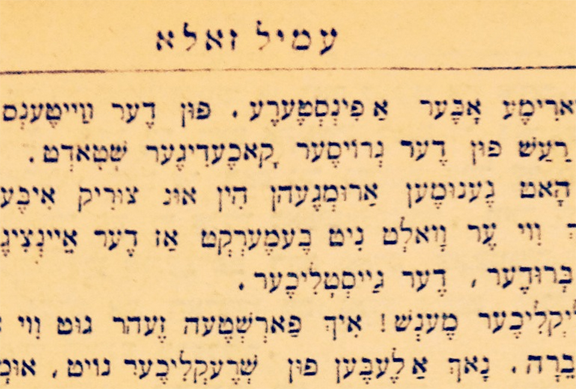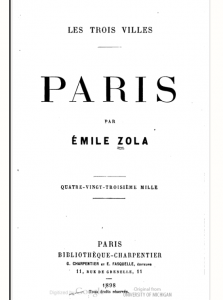Reading Zola in Yiddish

by J.D. ARDEN, Reference Services & Genealogy Librarian, Center for Jewish History, Reference Division & Genealogy Institute
117 years ago in January 1898, Emile Zola boldly took up his pen to bring those famous words, “J’accuse…!,” to the defense of Alfred Dreyfus, a Jewish artillery officer in the French army, whose conviction of espionage was widely believed to be an expression of anti-Semitism. The same year, Zola’s third book of the Three Cities Trilogy, Paris, was published—and subsequently translated into Yiddish in Warsaw by Israel Chaim Zagorodski. That book, in two editions, is in the collection of the YIVO Library.
At the time, Jews in France were emancipated citizens with equal rights. Notions of political freedom and heroism had been stirring not only in the pages of romantic novels, but were also beginning to be reality in the daily lives of Jews in some European countries.
 With civic freedom, came an expansive sense of culture and literature – and new opportunities for Jewish multilingualism. This was the beginning of a long era of a Jewish secular feeling of belonging to, or at least having a legitimate right to participate in, the national majority cultures of much of Europe. Whether that era is now coming to a close in France remains to be seen. As Jewish immigration from France to Israel more than doubles from last year to this year (according to Jewish Agency statistics), and as those Jews will eventually trade in French for Hebrew as a literary medium, the pages of this 1898 Yiddish translation of Zola seem to stand as witnesses to the fading of a Diaspora Jewish community that once again finds itself under attack.
With civic freedom, came an expansive sense of culture and literature – and new opportunities for Jewish multilingualism. This was the beginning of a long era of a Jewish secular feeling of belonging to, or at least having a legitimate right to participate in, the national majority cultures of much of Europe. Whether that era is now coming to a close in France remains to be seen. As Jewish immigration from France to Israel more than doubles from last year to this year (according to Jewish Agency statistics), and as those Jews will eventually trade in French for Hebrew as a literary medium, the pages of this 1898 Yiddish translation of Zola seem to stand as witnesses to the fading of a Diaspora Jewish community that once again finds itself under attack.
What is striking about reading this edition of Zola in Yiddish is, first of all, the beautiful typography – stylized and ornamented with full vowel markings and antiquated spelling, and secondly, the richness of the Hebrew vocabulary. Both of these details lend an air of sophistication and classicism that fit perfectly in the context of an Emile Zola translation.
The three cities of this Emile Zola tri-part work were Lourdes, Rome, and Paris. The vibrancy, drama and intrigue of the times come through in the text and the vocabulary. The choice of the beautiful Yiddish typography was also, I believe, indicative of the zeitgeist and tone that the work conveys. Certainly, the Romantic era of European arts and literature has passed. Whether the era of a Jewish culture in Europe will also pass remains to be seen.
Read an English translation of Zola's Three Cities.
Further reading:
- Read about the writer/translator Yisra’el Ḥayim Zagorodski in the YIVO Encyclopedia of Jews in Eastern Europe.
- Read about the Dreyfus Affair.
- Read about antisemitism and Jewish identity in France today.
J.D. Arden responds to and blogs about historical reference and genealogy questions at the Genealogy Institute of the Center for Jewish History.